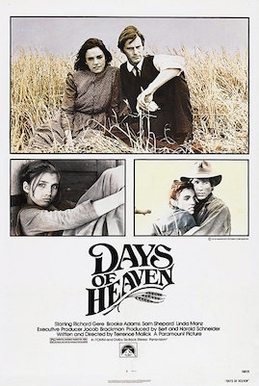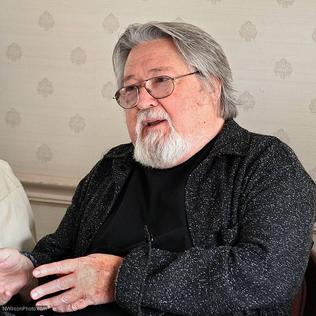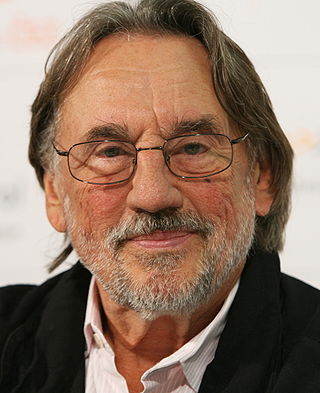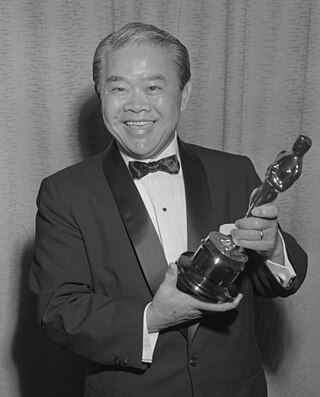
Days of Heaven is a 1978 American romantic period drama film written and directed by Terrence Malick, and starring Richard Gere, Brooke Adams, Sam Shepard and Linda Manz. Set in 1916, it tells the story of Bill and Abby, lovers who travel to the Texas Panhandle to harvest crops for a wealthy farmer. Bill persuades Abby to claim the fortune of the dying farmer by tricking him into a false marriage.

Gregg Wesley Toland, A.S.C. was an American cinematographer known for his innovative use of techniques such as deep focus, examples of which can be found in his work on Orson Welles' Citizen Kane (1941), William Wyler's The Best Years of Our Lives (1946), and John Ford's The Grapes of Wrath, and The Long Voyage Home. He is also known for his work as a director of photography for Wuthering Heights (1939), The Westerner (1940), Ball of Fire (1941), The Outlaw (1943), Song of the South (1946) and The Bishop's Wife (1947).

László KovácsASC was a Hungarian-American cinematographer who was influential in the development of American New Wave films in the 1970s, collaborating with directors including Peter Bogdanovich, Richard Rush, Dennis Hopper, Norman Jewison, and Martin Scorsese. Known for his work on Easy Rider (1969) and Five Easy Pieces (1970), Kovács was the recipient of numerous awards, including three Lifetime Achievement Awards. He was an active member of the American Society of Cinematographers and was a member of the organization's board of directors.

American Cinematographer is a magazine published monthly by the American Society of Cinematographers. It focuses on the art and craft of cinematography, covering domestic and foreign feature productions, television productions, short films, music videos and commercials.

Vilmos ZsigmondASC was a Hungarian-American cinematographer. His work in cinematography helped shape the look of American movies in the 1970s, making him one of the leading figures in the American New Wave movement.

Wong Tung Jim, A.S.C. (Chinese: 黃宗霑; August 28, 1899 – July 12, 1976), known professionally as James Wong Howe (Houghto), was a Chinese-born American cinematographer who worked on over 130 films. During the 1930s and 1940s, he was one of the most sought after cinematographers in Hollywood due to his innovative filming techniques. Howe was known as a master of the use of shadow and one of the first to use deep-focus cinematography, in which both foreground and distant planes remain in focus.

Charles G. Rosher, A.S.C. was an English-born cinematographer who worked from the early days of silent films through the 1950s.

Frederick A. YoungOBE, BSC was a British cinematographer. He is probably best known for his work on David Lean's films Lawrence of Arabia (1962), Doctor Zhivago (1965) and Ryan's Daughter (1970), all three of which won him Academy Awards for Best Cinematography. He was often credited as F. A. Young.
Néstor Almendros Cuyás, ASC was a Spanish cinematographer. One of the most highly appraised contemporary cinematographers, "Almendros was an artist of deep integrity, who believed the most beautiful light was natural light...he will always be remembered as a cinematographer of absolute truth...a true master of light".

Arthur Edeson, A.S.C. was an American cinematographer. Born in New York City, his career ran from the formative years of the film industry in New York, through the silent era in Hollywood, and the sound era there in the 1930s and 1940s. His work included many landmarks in film history, including The Thief of Bagdad (1924), All Quiet on the Western Front (1930), Frankenstein (1931), The Maltese Falcon (1941), and Casablanca (1942).

Easy Riders, Raging Bulls: How the Sex-Drugs-and-Rock 'N Roll Generation Saved Hollywood is a book by Peter Biskind, published by Simon & Schuster in 1998. Easy Riders, Raging Bulls is about the 1960s and 1970s Hollywood, a period of American film known for the production of such films such as The Godfather,The Godfather Part II,The French Connection,Chinatown,Taxi Driver,Jaws,Star Wars,The Exorcist, and The Last Picture Show. The title is taken from films which bookend the era: Easy Rider (1969) and Raging Bull (1980). The book follows Hollywood on the brink of the Vietnam War, when a group of young Hollywood film directors known as the "movie brats" are making their names. It begins in the 1960s and ends in the 1980s.

Arthur Charles Miller, A.S.C. was an American cinematographer. He was nominated for the Oscar for Best Cinematography six times, winning three times: for How Green Was My Valley in 1941, The Song of Bernadette in 1944, and Anna and the King of Siam in 1947.
Cinematographer Style is a 2006 American documentary film directed by Jon Fauer, ASC, about the art of cinematography. In the film, Fauer interviews 110 leading cinematographers from around the world, asking them about their influences and the origins of the style of their films.

John Ira BaileyASC was an American cinematographer and film director known for his collaborations with directors Paul Schrader, Lawrence Kasdan, Michael Apted, and Ken Kwapis. In August 2017, Bailey was elected president of the Academy of Motion Picture Arts and Sciences. He was succeeded by casting director David Rubin in August 2019.
Philippe Rousselot, AFC, ASC is a French cinematographer and film director best known for his wide range of work in both European and mainstream American cinema, ranging in genres from drama, to fantasy, to blockbusters. He has collaborated with directors such as Robert Redford, Neil Jordan, Stephen Frears, Tim Burton, David Yates, and Guy Ritchie. He is the recipient of three César Awards, a BAFTA, an Oscar, and is a nominee for the Palme d'Or.

Bert Lawrence Glennon was an American cinematographer and film director. He directed Syncopation (1929), the first film released by RKO Radio Pictures.

No Subtitles Necessary: Laszlo & Vilmos is a 2008 American documentary film written and directed by James Chressanthis.

Klaudia Kovács is a Hungarian film and theater director, known for her documentary Torn from the Flag.
The National Society of Film Critics Award for Best Cinematography is an annual award given by National Society of Film Critics to honor the best cinematographer of the year.
Machines is a 2016 documentary by Rahul Jain. The film, Jain's debut, examines factory life at a large textile mill in Gujarat, India.















